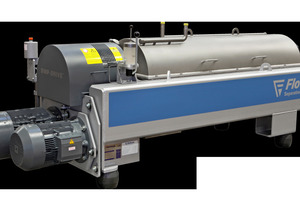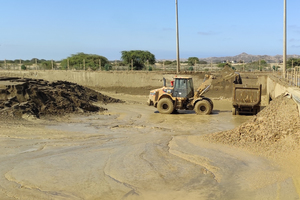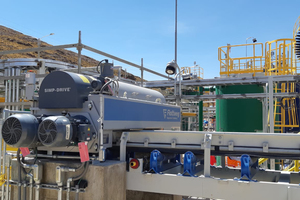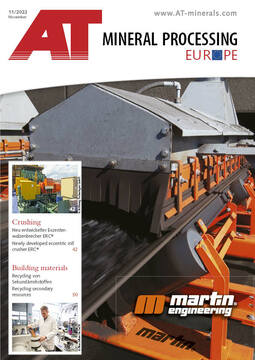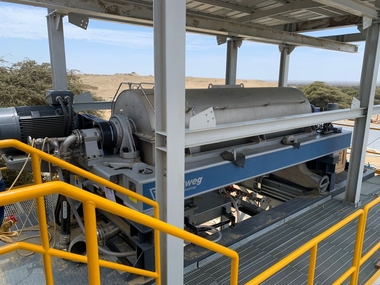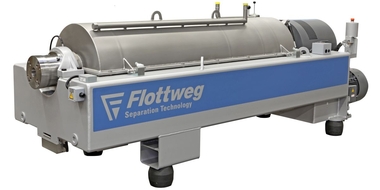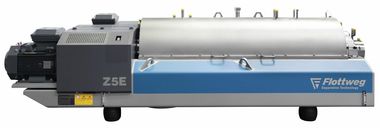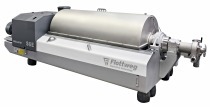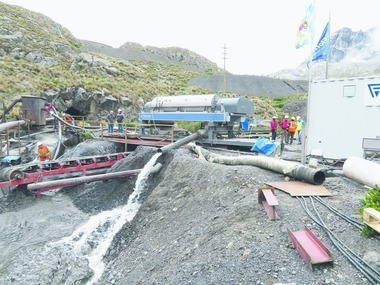Dewatering of neutralized acidic sludges
Flottweg decanters are multitalented in the mining industry, especially in the processing of ore, which plays a major role in the extraction of precious metals. For example, Flottweg’s decanter technology offers several advantages in the Lagunas Norte and Pucamarca gold mines in Peru, including: The volume of solids generated was reduced threefold, transportation costs were lowered and dewatering time was shortened. A continuous process was also provided for storage or relocation of the neutralized acidic sludge in dewatered form and to recover water for treatment.
Two gold mines in Peru: Lagunas Norte and Pucamarca
The Lagunas Norte mine is located in the Quiruvilca district in the province of Santiago de Chuco and in the La Libertad region in the north of Central Peru. Barrick owns the gold-silver mine and operates it through its Peruvian subsidiary Minera Barrick Misquichilca (MBM). Mining in Lagunas Norte occurs in a conventional open-cast mine with trucks and shovels on dumps. The mining takes place on a mountain top between 3800 and 4200 meters, above sea level. At the Laguna Norte processing plant, ore is crushed in two stages in a conventional crushing cycle with a capacity of 42 000 t/d. The crushed ore is loaded into haul trucks and transported to the leaching area for heap leaching. A processing plant with a capacity of 6000 t/d for grinding, flotation, autoclave, and carbon-in-leach was installed to process the material. The treatment plant required an investment of approximately 640 million US$.
Due to its low production costs and high operational efficiencies, Pucamarca is one of the most profitable gold mines in the world. Minsur is primarily dedicated to the exploration and processing of ore deposits and is a leader in the international tin market. Minsur entered the gold market via the Pucamarca mine, which went live in February 2013. Pucamarca is the mining unit that is paving the way for Minsur’s productive diversification. Located on the country’s southern border, this gold project represents a new mining model, meeting the highest international standards for operations, environment, safety, and social responsibility.
The challenge: The concentration of neutralized acidic sludge
Both mining units in Peru – Pucamarca (Minsur) and Lagunas-Norte (Barrick) – generate acidic wastewater at a rate of 10 m³/h as part of their heap leaching procedure and carbon-in-pulp (CIP) process using activated carbon, which is then neutralized with milk of lime to achieve a pH value of 8 – 8.5.
The resulting neutralized sludge (hydroxides) with a concentration of 6 – 10% w/w DS was then discharged into static sedimentation ponds (or into tanks, in Lagunas Norte’s case), from which 3 tank trucks made 15 disposal trips each. A total of 45 tank truck trips per day were required.
The existing static sedimentation ponds only allowed for very slow sedimentation of the quasi-colloidal particles contained in the neutralized solids. In addition, dewatering in the sedimentation ponds proved to be too slow due to the hygroscopicity of the hydroxides in the solids. This resulted in high transportation costs and an environmental problem that led to the shutdown of the plant due to the accumulation of acidic sludge.
Why decanters are suitable for mining
Flottweg decanters are true talents in the mining industry – especially when it comes to processing liquid and solid mixtures. Decanter technology is used in various mining applications: Gold and silver, lead and zinc, nickel and copper, platinum and rare earths.
The separation technology solutions can be used in almost all extraction processes involving minerals, raw materials, and ores. The Flottweg decanter offers an effective solution for the processing of minerals and ores and is used in many applications.
In the mining industry, decanters offer lower operating costs because large volumes of product can be processed easily and continuously, which increases production efficiency. With added protection against wear and corrosion, a decanter is an effective means of reducing operating and maintenance costs. It also offers long service life and extended maintenance intervals, along with very short repair turnaround times. The high quality and purity of the end product leads to a fast ROI, and the decanter’s continuous and fully automated operation also reduces labor costs.
Decanters in the mining industry are also a solution for sludge treatment. The fully enclosed design of the machine prevents emissions and protects personnel and the environment.
Flottweg supplies the solution: Decanters help in Lagunas Norte and Pucamarca
Both mines have decided to use a Flottweg Z4E decanter. In order for the separation process to take place, the solids phase must have a specific weight greater than that of the liquid phase. The Flottweg decanter enables the solids and liquid phase to be separated in a continuous process within a single machine.
The adjustable weir plates are an outstanding feature of the Flottweg decanter. These adjustable weir plates allow the operator to optimize the pond depth, thus providing maximum flexibility and optimal separation results in all possible circumstances, even with changing feed mixes. The liquid phase is discharged via gravity, while the solids are conveyed by the scroll to the conical end, where they are discharged by centrifugal force.
The Flottweg SIMP-Drive® is another feature of the decanter centrifuge. The SIMP-Drive® is a unique gear system, with two frequency inverters that enable independent operation of the scroll and bowl. Automatic, infinitely variable adjustment of the scroll speed to the incoming solids concentration in the feed makes fully automatic operation possible. The great advantage of this development is that Flottweg decanters are the most energy-efficient machines on the market, with the lowest installed power capacity compared to all other manufacturers. This technology offers the benefit of significant energy savings.
Conclusion
The use of Flottweg decanter technology in the two Peruvian gold mines, Pucamarca and Lagunas Norte, has increased the solids content by a factor of three, reduced transport costs, and shortened the dewatering time. It was also possible to create a continuous process for storing or relocating the dewatered neutralized acidic sludge and for recovering water for subsequent use in processing. For example, the Lagunas Norte gold mine saved approximately 560 000.00 US$ per year as a result of improved sludge dewatering and lower transportation costs. Consequently, Flottweg’s decanter centrifuge has already paid for itself after 6 months.
Author: Jimmy Córdova, Mining Sales and Project Engineer for Peru and Bolivia
Some of the specific results evident at the Lagunas Norte gold mine include
Situation without decanter technology (Lagunas Norte)
· Cost per hour to transport treated sludge (6 % w/w DS) - US$ 40.00
· 45 trips/day required, which corresponds to 15 trips per truck
· Number of operating hours per tank truck: 20 h/d * 3 tankers = 60 h/tank truck/day
· 60 h/tank truck/d x 40.00 US$ = 2400.00 US$ transportation costs for unprocessed sludge (6 % w/w DS)/day
· Transport costs per year: 2400.00 US$ x 350 days = 840 000.00 US$
With dewatered sludge (Lagunas Norte)
· Cost per hour for a tank truck to transport treated sludge (18 % w/w DS) - 40.00 US$
· 15 trips/day required, equivalent to one truck
· Number of operating hours per tank truck: 20 h/day * 1 tank truck = 20 h/tank truck/day
· 20 h/tank truck/day x 40.00 US$ = 800.00 US$ transport costs for processed sludge (18 % w/w DS) / day
· Transport costs per year: 800.00 US$ x 350 days = 280 000.00 US$
Cost savings
· Unprocessed sludge: 840 000.00 US$/a
· Processed sludge: 280 000.00 US$/a
· Cost savings: 560 000.00 US$/a
· Investment amortization: < 6 months

